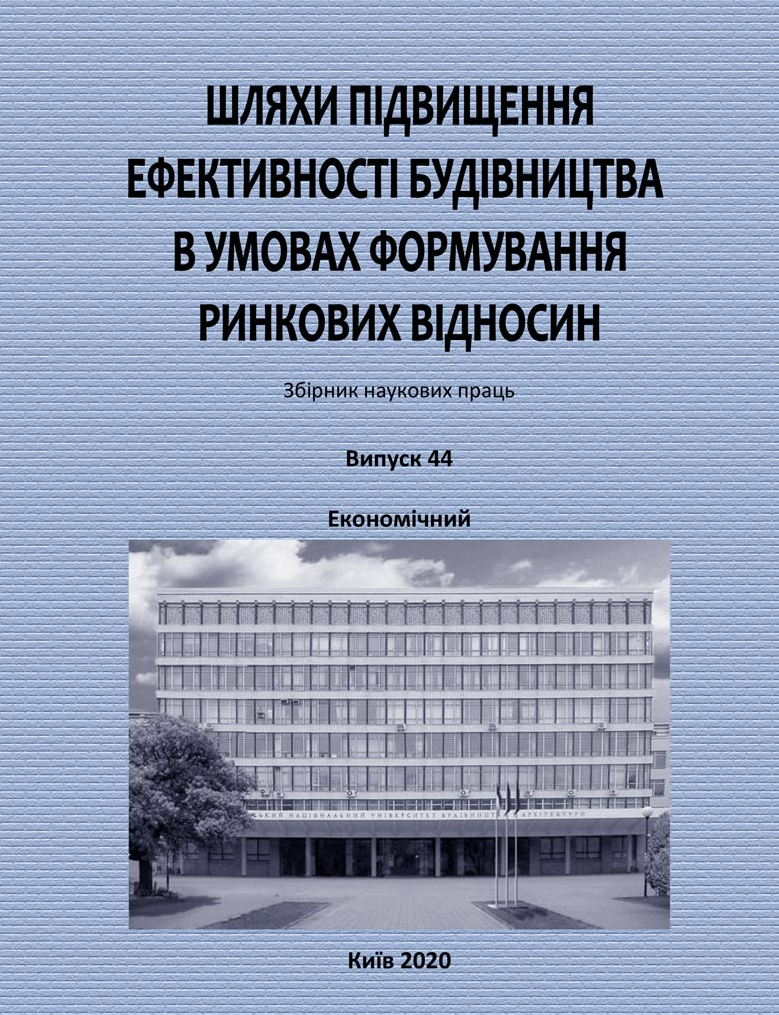Economic mechanism of risk management of investment projects in housing construction
DOI:
https://doi.org/10.32347/2707-501x.2020.44.40-47Keywords:
construction organization, investment activity, risk management.Abstract
The article reveals some problems of risk management of investment activity of construction companies.
The features of construction as a branch of production are defined, which are as follows: the long-term nature of investments in construction, a significant time gap between the moment of making investments and the moment of earning, as well as the risks of uncertainty of innovative activity. Their totality forms an extremely unstable environment for construction companies. The existing risk classifications by the following categories and features are considered: by the nature of economic activity of a construction organization (which in turn is divided into production, investment, innovation, commercial, etc. should separate relevant risks); the degree of controllability of the risks of a construction organization should be divided into unmanaged, hard-managed, well-managed; the source of risk factors should distinguish between the risks of the external and internal environment. The stages of the process of risk management of investment project activity in conditions of environmental uncertainty are presented: analysis of the external and internal environment of the investment project; determining the probability (frequency) of the event; Identifying the extent and magnitude of investment risk; determination of consequences of manifestation of risks (increase in prices of works, losses, increase of duration of construction, etc.); the choice of the necessary methods of minimizing the negative consequences, primarily aimed at reducing financial and other losses.
The peculiarities of investment activity in the sphere of construction, the main risks in the implementation of investment projects are considered. There are various approaches to managing the risks of investing in the construction of construction projects. Integrated use or combination of the proposed methods and tools allows to increase the economic security of the implementation of risky investment projects, as well as to achieve and further maintain an acceptable level of risks of the investment activities of the organization.
References
1. Asaul, A.N. (2006) Teoriya i metodologiya institucionalnih vzayemodij sub'yektiv investicionno-budivelnogo kompleksu.
Innovaciyi v budivelnomu klasteri: bar'yeri i perspektivi: zvit innovacijnogo byuro "Ekspert".M., 2007.
Lanskov, A.V. Fomin, E.P. & Chumak, V.A. (2005) Klassifikciya, analiz i upravlinnya rizikami na pidpriyemstvi.
Verhorubova, N. A.(2017) Osnovni metodi upravlinnya finansovimi rizikami pidpriyemstva. Ekonomika, Sociologiya i Pravo. - № 3. - 24-27.
Grachova, M. V. (2009) Rizik-menedzhment investicijnogo proektu: navch. posib. dlya studentiv vuziv, sho navchayutsya za ekonomichnimi specialnostyami, M.: YuNITI-DANA, 2009. - 454 s.
Doronkina, L. M. (2007) Upravlinnya investicijnimi rizikami v budivnictvi: avtoref. dis. d-ra ekon. Nauk, M.: 2007. - 42 s.
7. Lobanova, A. A. (2009) Enciklopediya finansovogo rizik-menedzhmentu - M.: Alpina biznes Buks, - 239 s.
Hodiryeva, Ye. A. (2017) Problemi upravlinnya rizikami innovacijnih osvitnih proektiv. Naukovo-metodichnij elektronnij zhurnal «Koncept». - № 2. - 165-172.
Stetsenko, S.P. & Ilina, T.A. (2019) Ilina Iierarkhichna model otsiniuvannia infrastrukturnykh ryzykiv pidpryiemnytskoi diialnosti u budivnytstvi. Naukovi pratsi NDFI, 1, 74-84. - URL: http://nbuv.gov.ua/UJRN/
Ekonometrychnyi instrumentarii upravlinnia finansovoiu bezpekoiu budivelnoho pidpryiemstva : [monohr.] / L.V.Sorokina, S.P.Stetsenko, A.F.Hoiko, K.V.Izmailova ta in. / Za nauk. red. d.e.n., prof. L.V.Sorokinoi. — K.: KNUBA.
Downloads
How to Cite
Issue
Section
License
Copyright (c) 2020 О. P. Poliak

This work is licensed under a Creative Commons Attribution 4.0 International License.
Authors who publish with this journal agree to the following terms:
- Authors retain copyright and grant the journal right of first publication with the work simultaneously licensed under a Creative Commons Attribution License that allows others to share the work with an acknowledgement of the work's authorship and initial publication in this journal.
- Authors are able to enter into separate, additional contractual arrangements for the non-exclusive distribution of the journal's published version of the work (e.g., post it to an institutional repository or publish it in a book), with an acknowledgement of its initial publication in this journal.
- Authors are permitted and encouraged to post their work online (e.g., in institutional repositories or on their website) prior to and during the submission process, as it can lead to productive exchanges, as well as earlier and greater citation of published work (See The Effect of Open Access).

